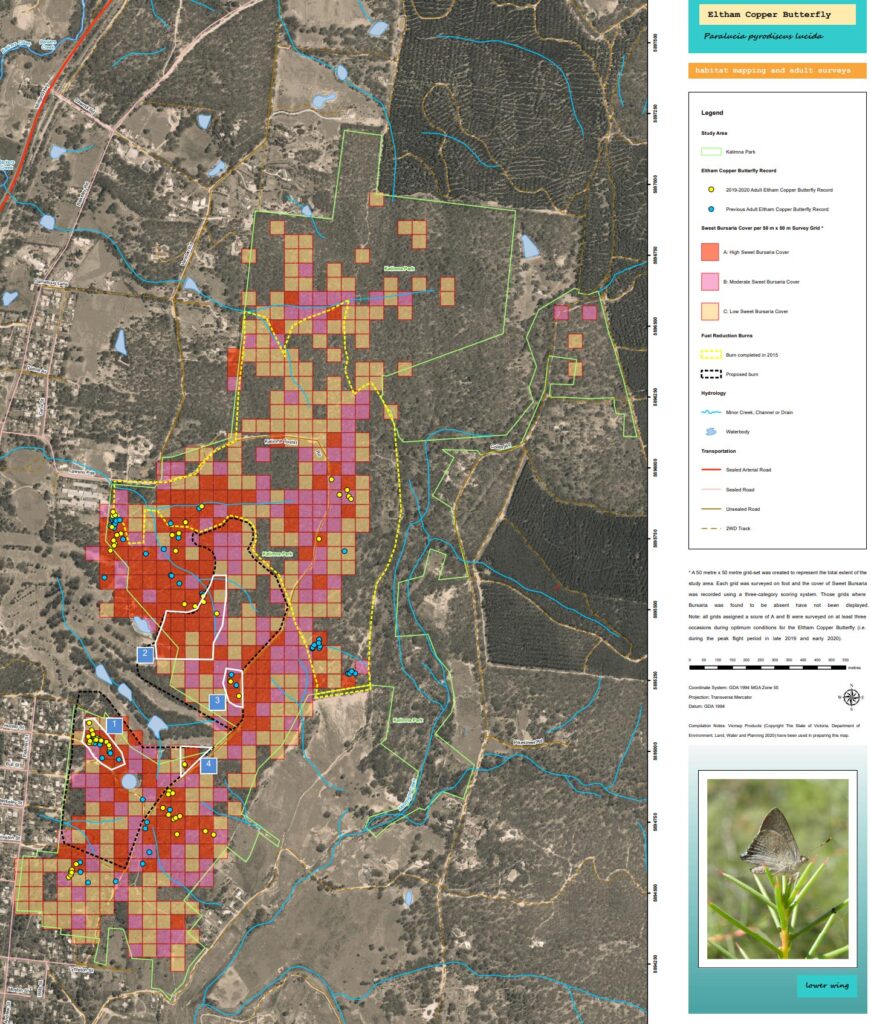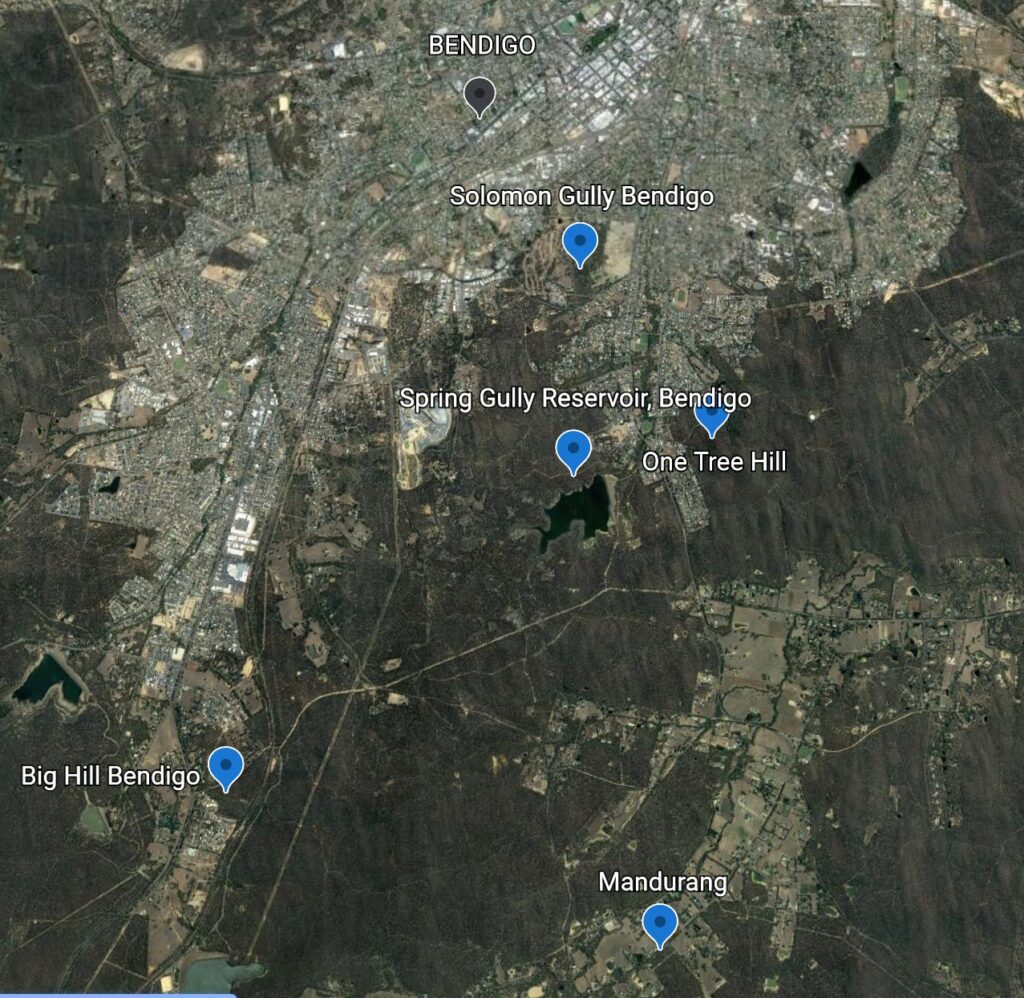Current Northern Victorian Distribution as of Jan 2022
As of January 2022 there has been very little monitoring or management at most of the known ECB populations in northern Victoria. It is therefore very difficult to comment on either the area of ECB habitat or the numbers of ECB within these populations.
ECB are very elusive. ECB only emerge as adults for a few days (7-28), only over a few summer months and only when conditions are hot and still. Determining the actual population size is very difficult. The only way to determine populations size with any confidence is by catch and release which is intrusive and expensive.
In North Central Victoria where thirteen small colonies occur within National Parks managed by Parks Victoria or other government managed land. In these areas it is believed they exist as a metapopulation, that is in a number of small colonies peppered through an area which are able to move between small patches and exchange genetic material. The populations which were discovered in 2011 were mostly a small number of individual sightings.
The table below provides a rough estimate of population sizes.
Some of the smaller remnants have had sporadic monitoring over the years (Castlemaine Botanic Gardens and Kiata and Salisbury). However in larger remnants for example in North Central metapopulations of 1-5 ECB peppered over a large area of remnant makes estimating the size very challenging.
| Date Discovered | Rough estimate of area of ECB habitat | Approximate Current ECB numbers (past max recorded) | |
| Castlemaine | 200-400 ha | unknown | |
| Kalimna Park | 2002 | 74ha (292ha) | 113 |
| Botanic Gardens northern section | 1988 | 5 ha (14.4ha) | 4 (50-100) |
| Dingo Park Road | 2011 | unknown | 50-100 |
| Broad Road, Campbells Creek | 2011 | unknown | Unknown |
| Walmer State Forest | 2011 | unknown | unknown |
| Bendigo | 5 areas with approx. 200 ha (16 ha Bursaria) | unknown | |
| Mandurang | 2011 | 4-10 hectares | unknown |
| Solomon Gully | 20ha (4 ha Bursaria, within 20ha reserve) | Unknown | |
| Burn Street, Spring Gully | 4ha within 26 ha reserve | unknown | |
| The Channel | 2ha within 1-200 ha reserve | unknown | |
| Big Hill Primary School | 2007 | 2ha within 12 ha reserve | 50-100 |
| One Tree Hill | unknown | unknown | |
| Spring Gully Reservoir | 2020 | 1 ha (303 ha) | 6-7 |
North Central Victoria – Castlemaine
There are five ECB populations as of Jan 2022 in Castlemaine area.
The largest area of ECB habitat which supports a number of metapopulation sites is Kalimna Park.
A smaller but older known location is Castlemaine Botanic Gardens which was discovered in 1988.
The other three sites were discovered in 2011 as part of a 3000ha search for ECB (Bayes, et al., 2012). All these sites are small numbers of ECB (1-5) which within larger areas of national park or state forest. These sites probably represent a larger metapopulation. More surveys are required to map the distribution of this elusive species. All three populations are within Asset Protection Zones which means they are burnt to 80% fuel reduction every 5-7 years.
There are thousands of hectares of Box Ironbark forest within the Diggins National parks in north central Victoria, most of which has not been surveyed for ECB. It is highly likely that numerous very small clusters of ECB occur within these areas. So new populations may exist which are currently unprotected from threats, particularly planned burns.

Kalimna Park
Kalimna Park has had sporadic ECB sightings since their discovery in 2002. In 2019 the entire park was mapped for ECB habitat. This allowed adult ECB searches to be focussed and more ECB populations found (see diagram). This site is the largest known ECB populations. While is is protected within a national park it is in an Asset Protection Zone and is therefore burnt to 80% fuel reduction every 5-7 years (see threats section).

ECB Records at Kalimna pre 2018

ECB records and Bursaria habitat mapping which helped focus ECB searches and find 5 new colonies in 2019-20 (yellow area was 2020 burn which is to be carried out again in 2022)
Castlemaine Botanic Gardens
Castlemaine Botanic Gardens discovered in 1988 as part of state-wide search (Vaughan 1988). This site is managed by Mount Alexander Shire Council. Sporadic past monitoring and annual transects in 2011 and from 2019-22 indicate that this population is in decline.
Past maximum numbers of ECB seen were 50-100, however 2019-2021 transects found between 4-11 ECB have been recorded. There are no obvious threats at this site. Changes may have occurred to vegetation however without monitoring data it is not possible to comment. Woody weeds have been managed both by the shire and by volunteers from the Castlemaine Field Naturalis Club for decades. It may be that this population are in genetic decline.
Castlemaine ECB Metapopulations within Reserves
Castlemaine South: Dingo Park Road, Chewton and Broad Road, Campbells Creek are within the National Diggings National Park and Walmer State Forest. ECB were discovered in state-wide search in 2011 (Bayes et al 2011).
Bendigo

Number of ECB at these sites and ECB distribution over these sites is unknown. Most sites are in Asset 1 protection zones, that is they are burnt every year to 80% fuel reduction. Large areas have not been searched for ECB. So new populations may exist which are currently unprotected from threats, particularly planned burns.